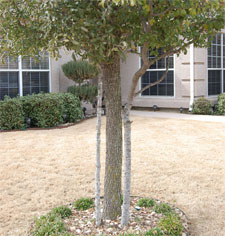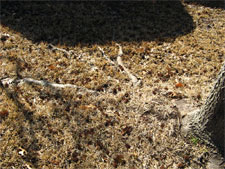Question and Answer – April 2010
(Note to our readers: Remember that we need two things to use your question here. We need your home city, so our answer can be as accurate as possible. And, we require a photo. Call Neil’s radio program if you don’t have a photo. We reserve this for the visual questions. Your photo does not have to be high-resolution. In fact, it’s easier, both for you and for us, if it is not.)
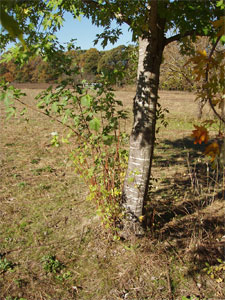
Question: We have a maple tree that has sprouts coming up around the base of its trunk. We have to cut them constantly. What can we do to keep them from coming back? JSR, Sulphur Springs.
Answer: It looks like there has been some type of damage or injury to this tree’s trunk at some time in the past, almost as if a line trimmer might have scored the trunk near the ground line, or perhaps a rodent might have chewed through its bark. These new shoots are probably developing around that injured tissue as the tree’s mechanism of surviving. Remove them carefully with a sharp pair of shears or even a knife, taking pains not to cause any further injury to the bark on the trunk. They will eventually give up if you do it often enough. That presumes that the top growth of the tree has enough vigor to keep itself going.
Question: We recently bought a house. I’ve attached a photo of the three-trunk tree. They had tied the trunks together in the top using plastic. Should we cut the two smaller trunks out, and let the dominant trunk take over? W., Denton.
Answer: This is really odd-looking. By all means, those two smaller trunks should be eliminated. Without them, you have a lovely small tree ready to take off. With them, you have a problem waiting to happen.
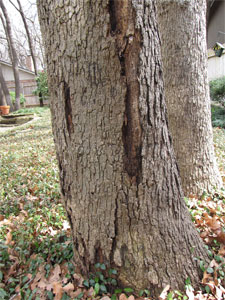
Question: I have an oak tree that is losing its bark. Of 15 trees, only this one is doing this. The bark is cracking, and it lifts off easily. It started at the bottom, and has worked its way up the trunk. Is there something I should do? S.M., Arlington.
Answer: There was probably some type of injury at the base of the tree years ago, or else a small branch was not removed properly. In either event, some type of decay, it appears, set in. It looks like the trunk is trying to heal. You can see the roll of new bark that is forming within the wound. If the top of the tree is healthy and vigorous, it will probably continue to get better. However, monitor it regularly. Better yet, get a certified arborist on the task to help you. Do not attempt to dig around in the cavity, and do not try to fill it with anything.
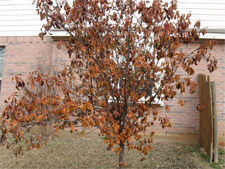
Question: I have had a problem with my photinia tree. It was fine before winter, but by late fall, its leaves had turned brown. However, they never dropped from the tree. What could be wrong? R., Mansfield.
Answer: I fully expected to see Entomosporium fungal leaf spot when I opened your photo files, but that awful disease was not involved in this plant’s problems. It really looks like it just got too dry at some point, one time. Unless it accidentally got dosed with some type of weedkiller, ice cream salt, or some other exotic option, dry soil is about the only possibility. It will not come back from being this browned, so you need to figure a replacement. Honestly, I’d choose some other type of small tree such as a tree-form yaupon or Nellie R. Stevens holly, crape myrtle, or dwarf magnolia. Photinias are very risky due to that leaf spot.
Question: I have a 12-year-old sweetgum that is growing happily in our sandy clay soil. It has good color in its leaves, etc., but in the past year, it has started developing large surface roots. Can I remove these without harming the tree, or can I put soil over them? I don’t want to hurt the tree. D.F., Colleyville.
Answer: You can remove surface roots, but fall is the best time to do so. Since hot, dry weather is just ahead, the tree needs its roots in the summer. I would not suggest adding soil, because these roots will just continue to swell, and eventually, you’d have it to do over again. After a few years, you’d end up with a mound of soil beneath the tree. I have similar situations in several places, and I’ve used tall groundcovers to conceal the roots. Mondograss and purple wintercreeper euonymus are my two plants of choice.


